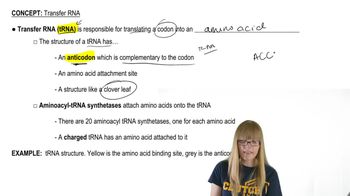Table of contents
- 1. Introduction to Genetics51m
- 2. Mendel's Laws of Inheritance3h 37m
- 3. Extensions to Mendelian Inheritance2h 41m
- 4. Genetic Mapping and Linkage2h 28m
- 5. Genetics of Bacteria and Viruses1h 21m
- 6. Chromosomal Variation1h 48m
- 7. DNA and Chromosome Structure56m
- 8. DNA Replication1h 10m
- 9. Mitosis and Meiosis1h 34m
- 10. Transcription1h 0m
- 11. Translation58m
- 12. Gene Regulation in Prokaryotes1h 19m
- 13. Gene Regulation in Eukaryotes44m
- 14. Genetic Control of Development44m
- 15. Genomes and Genomics1h 50m
- 16. Transposable Elements47m
- 17. Mutation, Repair, and Recombination1h 6m
- 18. Molecular Genetic Tools19m
- 19. Cancer Genetics29m
- 20. Quantitative Genetics1h 26m
- 21. Population Genetics50m
- 22. Evolutionary Genetics29m
10. Transcription
Overview of Transcription
Problem 1b
Textbook Question
Why are genes for rRNA and tRNA considered to be genes even though they do not produce polypeptides?
 Verified step by step guidance
Verified step by step guidance1
Understand the definition of a gene: A gene is a segment of DNA that contains the information necessary to produce a functional product. This product can be a polypeptide (protein) or a functional RNA molecule.
Recognize that not all genes code for proteins. Some genes are transcribed into RNA molecules that perform essential cellular functions without being translated into proteins.
Explain the role of rRNA (ribosomal RNA): rRNA is a structural and functional component of ribosomes, which are the molecular machines responsible for protein synthesis. It plays a critical role in catalyzing peptide bond formation and ensuring proper alignment of mRNA and tRNA during translation.
Explain the role of tRNA (transfer RNA): tRNA is responsible for delivering specific amino acids to the ribosome during translation, based on the codon sequence of the mRNA. It acts as an adaptor molecule, linking the genetic code to the amino acid sequence of proteins.
Conclude that rRNA and tRNA genes are considered genes because they produce functional RNA molecules that are essential for cellular processes, even though they do not produce polypeptides. Their products are directly involved in the machinery of gene expression and protein synthesis.
 Verified video answer for a similar problem:
Verified video answer for a similar problem:This video solution was recommended by our tutors as helpful for the problem above
Video duration:
3mPlay a video:
Was this helpful?
Key Concepts
Here are the essential concepts you must grasp in order to answer the question correctly.
Non-coding RNA
Non-coding RNAs (ncRNAs) are RNA molecules that are not translated into proteins. They play crucial roles in various cellular processes, including gene regulation and protein synthesis. rRNA (ribosomal RNA) and tRNA (transfer RNA) are types of ncRNAs essential for the translation process, facilitating the assembly of amino acids into polypeptides.
Recommended video:
Gene Definition
A gene is traditionally defined as a segment of DNA that encodes a functional product. This product can be a protein or a functional RNA molecule. Therefore, genes for rRNA and tRNA are still considered genes because they encode functional RNA products that are vital for cellular functions, despite not coding for polypeptides.
Recommended video:
Guided course

Mapping Genes
Role of rRNA and tRNA
rRNA and tRNA are integral components of the ribosome, the cellular machinery responsible for protein synthesis. rRNA forms the structural and functional core of the ribosome, while tRNA serves as an adaptor that brings amino acids to the ribosome during translation. Their roles are essential for the accurate and efficient synthesis of proteins, highlighting their importance as gene products.
Recommended video:

 6:32m
6:32mWatch next
Master Overview of Transcription with a bite sized video explanation from Kylia
Start learningRelated Videos
Related Practice
Multiple Choice
What is the primary purpose of transcription in eukaryotic cells?
2
views


